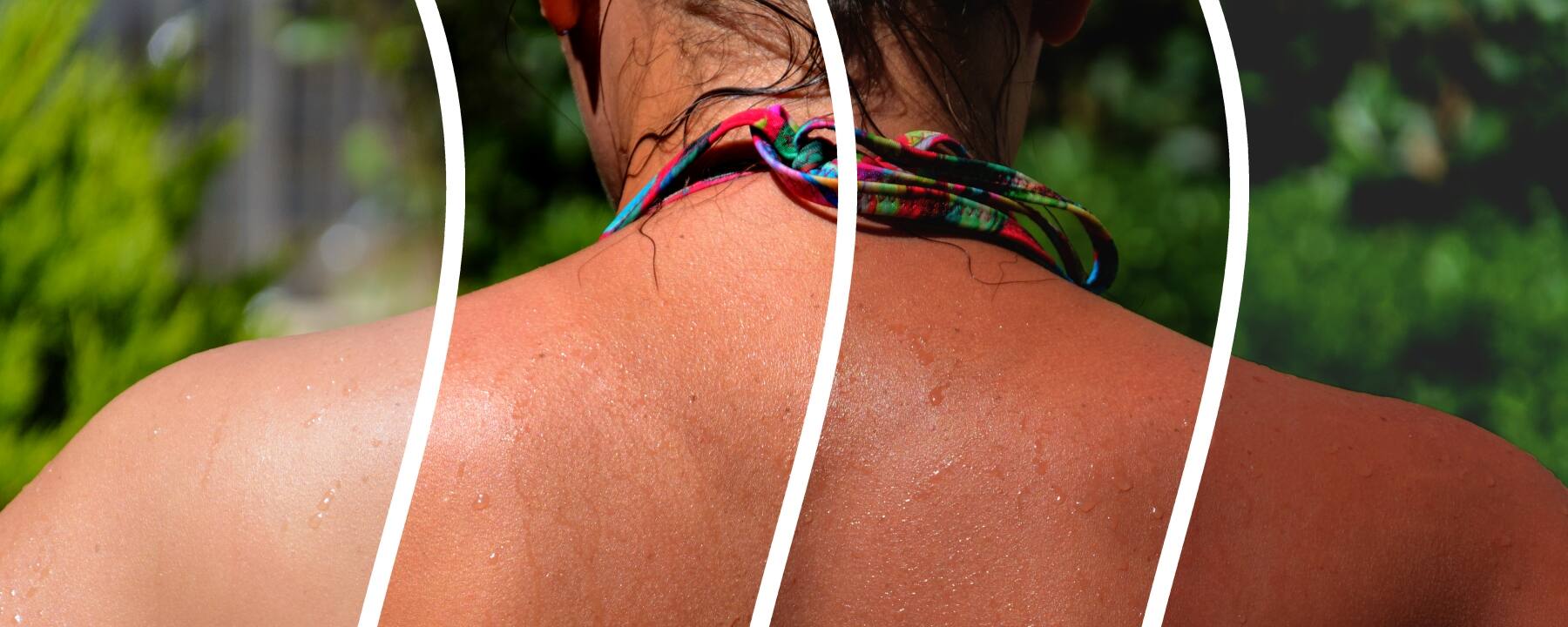
Skin and skin types
The skin’s natural protection
Not only does our skin make us look good – the body’s largest organ also performs many tasks that protect us. Sun protection is one of them. Nevertheless, we should not overestimate this natural protection against UV radiation.
Who doesn’t like returning from vacation well-rested and with a fresh, sun-kissed complexion? But is a suntan a healthy sign for the skin? It is a sign first and foremost that the skin is reacting to the UV radiation present and has effectively switched to protection mode. It has activated its own UV protection (UV adaptation).
“Hey, I have my own UV protection. I don’t need to buy sunscreen anymore.” The first statement is true, while the second is not only foolish, but also dangerous. You mustn’t overestimate your skin’s capabilities – support your skin by applying the right sunscreen.
When we talk about the skin’s natural protection, we inevitably also need to talk about skin types. After all, not all natural protection is the same and it essentially depends on the skin type you have. Since 1975, the different skin types have been categorized on a scale that is still used today, with the classification being developed by American dermatologist Thomas B. Fitzpatrick. You can find out more in our article: What is your skin type?
Differences are significant
A distinction is made between six skin types (1 to 6). The skin type determines the sensitivity to erythema, i.e. how quickly a person gets sunburned, and the ability to tan. People with type 1 have very fair skin and should avoid direct sunlight. Their natural protection time against erythema is only five to ten minutes. They don’t tan. Skin type 6, on the other hand, is for people with dark brown to black skin. The natural protection time here is a maximum of 90 minutes. The differences are significant and cannot be lumped together, especially since the boundaries between the individual skin types are fluid rather than strict.
The UVB radiation that reaches us on Earth accounts for about 5% of all UV radiation that hits the Earth. The other 95% is in the longer UVA wave range. The amount and strength of solar radiation that ultimately finds its way to us humans varies, and depends on a number of factors and external influences. These include, in particular: time of day and season, degree of cloud coverage in the sky, geographical latitude, altitude above sea level and ozone concentration. These are all criteria that can influence the strength of solar radiation.
What happens when we encounter UV radiation without protection, or rather, when UV radiation hits our unprotected skin?
The components of natural UV protection
A small portion of the radiation is reflected directly at the surface of the skin. The larger part pushes through and literally penetrates the skin. The wavelength makes the difference when it comes to the penetration depth. UVB radiation is mainly found in the epidermis, while UVA rays can penetrate deeper into the skin and tissue. This is associated with chemical reactions and biological processes that are fundamental to our lives, but also involve dangers.
What to pay attention to
When we assess the sun protection factor, it is not a question of how much UV radiation is blocked or filtered, but of what proportion of UV radiation can penetrate and damage our skin. Example: SPF 15 sunscreens allow 6.6% of UV radiation to hit our skin. With SPF 30, 3.3% of UV radiation hits our skin, i.e. only half.
When we look at the skin’s natural protection, we find two components that are important:
- Skin tanning/formation of melanin
- Actinic keratosis
Skin tanning/formation of melanin
The skin’s exposure to UV radiation leads to the biosynthesis of melanin. Melanin is a pigment that is responsible for the color of our skin, hair and eyes and can also protect us against UV radiation. There are different types of melanin. Eumelanin exists in two variants: black and brown. The presence of eumelanin determines skin color, eye color and hair color. Pheomelanin (yellow – red) is responsible for the pigmentation of lips, nipples and all pink areas of the body. We should also briefly mention neuromelanin.
The skin cells are very sensitive to UV rays. This is why pigment cells (melanocytes) are located in the germinal layer. Stimulated by the radiation, they form the protective pigment, melanin. The melanin is then absorbed by the keratinocytes. As a result, we see a tanning of the skin, which absorbs UV and is supposed to protect the genetic material in the cells in the event of stronger sunlight.
Skin tanning can be divided into a) immediate or direct pigmentation and b) delayed pigmentation. UVA rays are responsible for a). Here, existing melanin pigments are essentially only darkened. A protective effect is hardly measurable. Although this tan appears very quickly, it also disappears again relatively quickly. UVB rays, on the other hand, cause a delayed tanning of the skin, which only occurs a few hours after sun exposure and lasts for several weeks. The tan only disappears again when the skin undergoes its completely natural renewal process. During this process, which lasts 30 days, the epidermis is constantly renewed (the renewal of the corneal layer takes about 14 days).
Albinism
If the formation of melanin is impaired or even impossible, this is called albinism. It is a genetic metabolic disorder that makes people look very pale (almost white). In addition to the skin, the hair and eyes are affected (poor eyesight + vision problems). It is caused by not enough melanin being produced. This is the body’s own pigment, which influences both skin color and natural protection against sunlight, and it may either not be produced at all or only to a very limited extent. There is no cure. Visual aids for weak eyes and particularly sunscreen are essential for leading the healthiest possible life.
A note for anyone who likes to “pre-tan” in a tanning booth: because of the UVA radiation present in tanning booths you will not build up your natural protection. Read more about tanning booths in our article here.
Actinic keratosis
If the skin is exposed to UV radiation over a longer period of time, what is known as “actinic keratosis” forms over the course of a few days (fully developed only after a few weeks). For medical professionals, these actinic keratoses are a consequence of UV-induced light damage to the skin. They cause a thickening or keratinization of the top layer of the skin. The increased cell division of the skin that leads to this thickening is triggered by both UVA and UVB rays. However, it is probably the UVB rays that have the greatest influence.
Even though our skin’s natural UV protection is a great characteristic: you shouldn’t rely on this alone. Be on the safe side by using sunscreens that reliably protect you against UVA and UVB radiation from our beloved sun. Take another look here: “How to protect yourself the right way”

